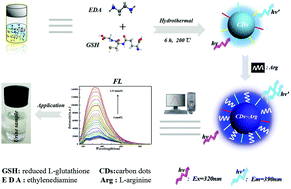A novel carbon dots derived from reduced l-glutathione as fluorescent probe for the detection of the l-/d-arginine
Abstract
In this report, water-soluble carbon dots (CDs) with stable fluorescence (FL) were designed and synthesized by using environment-friendly reduced L-glutathione (GSH) as the precursor and ethylenediamine (EDA) as the passivating agent through a one-step hydro-thermal method. The CDs, with bright blue FL, had the quantum yield (QY) of 40% and showed excellent monodispersity and solubility in water. The FL intensity was remarkably enhanced when a racemic modification of L-/D-arginine (Arg) was added into the CDs solution. Therefore, the CDs could be considered as a sensitive probe for the detection of Arg. Under optimized conditions, the CDs exhibited a linear fluorescence response in the range of 3–124 μM (R2 = 0.9987) Arg with the detection limit of 2.85 × 10−8 M. In addition, no evident difference was observed when comparing the FL results of L-Arg and D-Arg. Therefore, this method could not be used in the chiral recognition of two enantiomers. Under optimum conditions, the mechanism and the reasons for the enhancement of FL were investigated. The developed method exhibited great stability, selectivity and accuracy in determining the Arg content in human urine sample and the recovery range was from 97.0% to 102.2%. Thus, our proposed method has potential application in biological molecular recognition.



 Please wait while we load your content...
Please wait while we load your content...